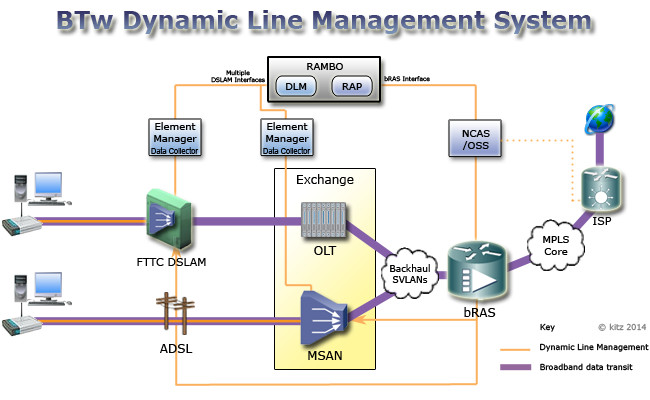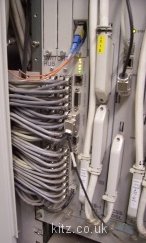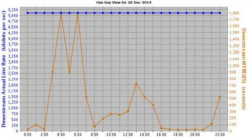On this page we take a look at Dynamic Line Management Systems. In particular we focus on BT Wholesale's DLM
System and describe the various parts involved and each of their functions.
~ DLM Introduction
BT Wholesale's Dynamic Line Management System is an extremely large topic. In an attempt to make it easier to digest, the subject has been split into several pages which you may find useful to aid understanding how the DLM works as a whole:
- The DLM System: - Looks at the hardware & software systems used to monitor broadband lines. Knowing what each device in the DLM system is responsible for and what it does helps to visualise DLM Management and the processes involved.
- The DLM Process: - Focuses on how the DLM system monitors a line and how it decides if any changes need to be made to your DLM profile. We describe in detail each process carried out by the DLM System, what algorithms are used and how the decision is made whether any changes need to be made to your DLM Profile.
- The DLM Profiles: - Although the DLM system & process is the similar regardless of product, there are some slight differences between what parameters the system can configure depending on whether you have ADSL1, ADSL2+ or FTTC. The DLM profiles page breaks down the differences between the products and what configuration changes can be made for each type of DSL. (Page not yet live.)
~ What is a Dynamic Line Management (DLM) system?
A Dynamic Line Management System is all the hardware devices and other components required to monitor customers lines for signs of broadband instability, and then apply software configuration changes in order to keep the line stable.
The DLM system is independent from, yet supplemental to DSL technology and helps to ensure that DSL broadband lines don't consistently drop when line conditions change.
All UK ISPs have some sort of DLM. Sky & TalkTalk LLU have their own DLM systems but most other ISPs will use the BT Wholesale DLM. Customers with Sky Fibre and TalkTalk Fibre will also use the BT Wholesale DLM.
~ Why do we need Dynamic Line Management?
Rate Adaptive DSL broadband will connect as fast as line conditions will allow. However, there are times when lines become unstable due to noise factors. Every time a DSL connection re-syncs to the exchange, the parameters change and sync speeds can vary. Noise causes errors such as CRCs & Errored Seconds which can cause the connection to become slow & laggy, or even drop out completely.
Interleaving and/or increasing the SNR Margin can help overcome line instability, but because all lines are different there is no one single one size solution that fits all. The DLM monitors your line and applies the parameters that it deems necessary to suit your line conditions and maintain stability.
The aim of a DLM system is to maximise a connection’s data rate and throughput speed, whilst maintaining stability of the line.
~ How does the DLM monitor your line?
There are several key components to BT Wholesale's DLM system. These comprise of :-
We will look at each component in turn to see what each part has to play in the DLM system.
~ Graphical representation of BT Wholesale's DLM System.

|
DLM related
|
DSL Equipment in the Exchange/Cab
|
Broadband Network
|
DLM = Dynamic Line Management
RAP = Rate Adaptive Profile
RAMBO = Rate Adaptive Management Box.
NCAS = Network Configuration & Assignment System
OSS = Operational Support System |
DSLAM = Digital Subscriber Line Access Multiplexor.
FTTC = Fibre to the Cabinet
MSAN = Multi Service Access Node
OLT = Optical Line Terminal
|
bRAS = Broadband Remote Access Server
MPLS = Multi Protocol Label Switching
SVLAN = Service Virtual LAN
|
~ What is a DLM Management Device (RAMBo)?
All of BT Wholesale's DSLAMs/MSANs in the exchange and each of the mini DSLAMs in the FTTC cabinets are connected to and communicate with the DLM Management Device.
BT call their management device "RAMBo" which stands for Rate Adaptive Management Box. It communicates with the plurality of DSLAMs/MSANs and also the bRAS to ensure correct profiles are applied to the line.
| RAMBo is basically a server type computer that contains a powerful CPU and large storage device. This enables it to process data from the Element Managers, and if necessary, adjust any DLM or RAP profiles. It also retains historical data for multiple lines. |
|
The Management Devices are located in a central location. Since 21CN the RAP function is a simpler procedure than when on 20CN and the DLM function has become more complex and the major function that the system now performs.
~ What does the DLM Management Device (RAMBo) do?
RAMBo is considered the key component when it comes to BT's DLM system. RAMBo is responsible for calculation of DLM profiles plus several processes which may not actually be part of the DLM, but are related to or rely on the main DLM function. These are:
- DLM Function. Every day RAMBo receives a data file from the DSLAM's Element Manager. Each file contains performance data for up to 96 * 15 min time slots per day. The data is stored as historical performance data and is used in the DLM algorithm to determine if the DLM profile currently being employed requires changing to stabilise the end users service.
The DLM Function and it's algorithm is a large topic which is covered on its own page.
- BRAS Control (RAP). The Rate Adaptive Profile (RAP) function is what determines your IP profile. The bRAS control element of the Management Device processes information about a line's sync speed to assess the 'consistent rate' achieved by each DSL connection.
If it detects that a particular connection's sync speed has changed, it will take the necessary action to amend the IP profile held at the bRAS. This helps too ensure that the bRAS does not allow
more traffic to flow to the connection than the line is able to cope with.
The RAP function and it's algorithm is a large topic on its own right and covered separately. See page: BT IP Profile.
- Monitoring for Wide Area Events. The most common form of wide area event is from thunderstorms, but there may be other similar external events that may cause a line to either resync or record a lot of errors. If a pre-determined percentage of lines also experience resyncs and/or high error rates during the same time frame, then these events will be classed as a wide area event and disregarded from the DLM calculation.
For more information on how the DLM management device monitors for wide area events see: DLM - Wide Area Events.
- Training & Stabilisation - Setting the MSR and FTR. The stabilisation period is a 'one off' event that occurs during the first 10 day training period with adsl
connections. Details about the MSR and FTR are explained elsewhere on the site: MSR & FTR.
FTTC does not have a training period. The FTR is set at 15Mbps for lines which sync at >15Mbps or 2Mbps for lines which sync between 2-15Mbps.
- Additional Line monitoring. Monitoring of SNR Margin does not normally occur for most lines. However, if a particular line continues to remain unstable outside of the normal DLM process steps then the Management Device will directly monitor the SNR Margin variance to determine if the line needs to be moved to a rate capped profile.
Additional Line monitoring will also be performed immediately if the system detects 10 retrains in any one hour period.
Note: A rate capped profile is not the same as the normal banding steps which occur during the FTTC DLM process. This would appear to be one of the Max Capped Rate Profiles mentioned on page 6/7 of SIN 485. ie Max Capped Rate Profile 2000.
~ What is an Element Manager?
Each DSLAM/MSAN is attached to an Element Manager. These are vendor specific interface modules and may vary depending upon the make and manufacturer of the DSLAM/MSAN. These modules are specifically designed to be an interface for the DSLAM to be able to directly communicate with the providers central Support System (the OSS).
Element Managers are used to monitor and configure DSLAMs/MSANs not just for DLM functions, but also provide status and make general configuration changes to the DSLAM/MSANs.
Not every DSLAM/MSAN has its own element manager. There are aggregation element managers which can collect and record data from more than one DSLAM. For example these could be used to manage multiple FTTC DSLAMs, so you could have several ECI cabs linked to an ECI Element Manager whilst several Huawei cabs may be linked to a Huawei Element Manager. Fujitsu DSLAMs (used for 20/21CN) have a master control shelf which can control multiple Fujitsu DSLAMs.
The benefit of element managers are that all of the DSLAMs/MSANs can be seamlessly monitored and configured from a remote location using the same support system software (see OSS), regardless of the make of DSLAM and its type of operating system. The element manager makes changes to and communicates with the DSLAM using the SNMP protocol. |

Fujitsu Master Control Shelf
|
~ What does an Element Manager do in the DLM system?
Because element managers are responsible for monitoring and making general configuration changes to the DSLAM anyhow, then it makes sense that the element manager should also be used to make configuration changes for the DLM as an additional function. In this type of scenario, the DLM management device 'sits' between the element manager and OSS.
The Element Manager periodically collects data from the Data Collectors and as part of the DLM function it processes information from the each of the 15 minute bins ready in preparation for the DLM Management Device.
The data recorded in each file used by DLM is:
- Uptime in seconds
- Sync speed
- Number of Errors (ES & SES)
- Number of Retrains and failed initialisations.
This information is then processed by the Element Manager to normalise retrains & errors to to the uptime. Once normalised this MTBE and MTBR data is passed on to the Management Device (RAMBO) in the following format:
- MTBE (Mean Time Between Errors) = Connection uptime / Errors or Code Violations
- MTBR (Mean Time Between Retrains) = Connection uptime / No of retrains
From the MTBE and MBTR results, RAMBo will decide if any DLM changes need to be applied. The DLM process and algorithm used by RAMBo is a large topic in its own right and discussed in more detail in a separate page: DLM process and DLM Algorithm.
Note: If the line is classified as very poor, this stage may be bypassed and direct monitoring may be undertaken by RAMBo and the DSLAM - see Additional Line Monitoring.
DLM data is sent from the element manager to the DLM management device using the RPC protocol every day. As part of the DLM process, it is the element manager that is responsible for distribution of the lines DLM profile to the DLSAM and it uses Data Collectors to collect information about the line. DLM Data Collectors are discussed in more detail below. |
~ Data Collectors.
Every DSLAM or MSAN has a data collector which records line data for each connection. The information stored in the data collectors contains various information about the line such as CRCs & numerous other error types as well as line conditions such as sync rate and connection uptime. Each day's monitoring period is divided into 96 x 15 minute bins.
Our own modem/router also has a data collector and some models allow the user to access this data to obtain a count of errors recorded on the line. Home routers also usually record using 15 min bins, although it may only retain data for 2 or 3 x 15 min bins before pushing this information on a cumulative stack.
A DSLAMs data collector is slightly more advanced in what it can record and has more memory so that it can store a plurality of data for numerous lines. For each line it monitors separate data sets and subsets. There are too many to list them all, but some of the main ones for the purpose of this tutorial are:
- Line Data
- Line Rate - Sync Speed & other bit rate related information
- Line Condition - ie Attenuation, SNR Margin, Power.
- Fault Finding Info - ie QLN, Hlog
- Event Counters
- Line Level - ie Initialisations and failed initialisations
- xTU Level - Alarm state errors such as LOS, ES, SES, UAS.
- Channel Level - Coding violations such as CRC & HEC and corrected blocks (FEC)
- Various configuration Parameters
- ie Interleaving, INP, Target SNR, SNR Margin, QoS Profiles, Max Line Rate, Min Line Rate.
DLM systems are interested in analysing the Line Rate and Event Counters, whilst it may make changes to the configuration parameters. Automated DLM systems usually use take a particular interest in the Event Counters which the Data Collector stores in the following format:
- 1 x 15 min current bin
- 96 x 15 minute history bins.
- 1 x current day
- 30 x previous days
Each current bin also has an associated threshold notification. This can be used to immediately notify the DLM Management Device if a line is performing particularly badly: ie 10 retrains in 'x' period of time will trigger an alert so that RAMBo can take immediate action.
The DLM system takes particular note of the Line Level & xTU Level Event Counters bins and their data is periodically sent over to the element manager for processing.
~ Knowledge Based Diagnostics - KBD
The data collector also records other stats about the line health which is used for fault diagnostics.
This system is known as KBD or Knowledge Based Diagnostics and whilst not part of the DLM process itself, it allows an ISP to view line data in depth and will show not only the MTBE & MTBR but other information such as SNR Margin, attenuation, power and error counters. This information is stored in an RRT database.
|
|
Data collected for KBD can be graphed and viewed using the RRT (Reactive Repair Tool).
The BRAT tool (Brandenburg Rapid Analysis Tool) can use this data to help identifty and spot faults such as those indicative of REIN.
|
~ What is NCAS and OSS?
Network Configuration & Assignment System (NCAS) and Operational Support System (OSS).
These are the software systems and support systems which make configuration changes to bRAS and DLM. Some of it's responsibilities (but not restricted to) are:
- Making a configuration change to the RAP profile at the bRAS.
ie: if the consistent sync speed has changed, then the BRAS/IP profile will be amended.
- Making configuration changes to DLM parameters - eg if a customer has requested Interleaving to be removed as a preference (adsl/adsl2/2+ only).
- Requests to reset the DLM profile or IP Profile.
- Reporting of DLM profiles & IP profiles to the ISP via BBCR
- Making configuration changes to the DSLAM
- Reporting and monitoring the DSLAM
- Running remote tests on a line.
DLM profiles are applied to the DSLAM. IP profiles are applied to the bRAS.
Note: In 2012 BT tested a new system of central Management Devices and whether they will be/are moving to using something like the Huawei U2000 system for OSS & DLM has not been publicly disclosed.
|






